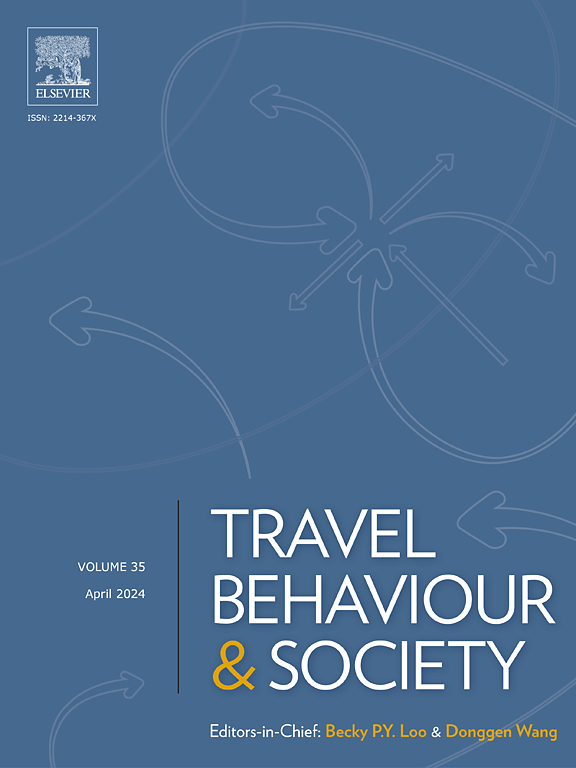基于 copula 的多模式需求相关性建模方法:地铁和共享单车需求之间的时间相关性
IF 5.1
2区 工程技术
Q1 TRANSPORTATION
引用次数: 0
摘要
作为共享交通的代表模式,共享单车不仅是城市地区短途出行的便捷方式,也是公共交通的接驳模式,形成了 "自行车与骑行(BnR)"系统。对这种多模式混合系统进行管理面临着各种挑战,包括共享单车与其他模式之间复杂的相互作用、高度动态的乘客需求以及难以获取直接换乘数据等。为了克服这些困难,我们的研究提出了一个评估两种使用模式之间依赖关系的框架。首先,利用基于动态时间战平(DTW)的方法确定两种模式之间的覆盖区域(CA),从而考虑在给定时间尺度下与 BnR 相关的趋势相似性。然后,通过基于 copula 的方法获得两种模式出行需求之间的概率依赖模式,该方法将特定使用水平下的相关性与单一模式需求分离开来。为了验证所提出的框架,我们对纽约由有桩共享单车和地铁组成的多模式系统进行了案例研究。研究发现,在 4 小时间隔内,平均 500 米范围内的趋势相似性最为明显。对于每个已形成的车站组(SG),选择了拟合效果最好的 copula 类型,以捕捉仅在特定使用水平下出现的强烈尾部相关性。结果显示,尽管 SG 的地理位置相近,但 SG 内部的相关模式却各不相同。两种模式之间存在潜在的转移阻力,这在第一英里相关活动(FMR)中更为明显。相比之下,在与最后一英里(LMR)相关的活动中,两种交通方式的联系更为薄弱。共享单车服务提供商可利用所得结果分析需求分布,并进行有效的站点级再平衡。与以前的方法相比,我们提出的框架计算成本低廉,因为不需要直接传输数据或复杂的推理网络。它结合了具有统计意义的时空信息,可以更准确地确定双模式评估范围。此外,考虑到在数学上剔除了单一模式的影响,由此得出的相关性原则上与两种模式之间的联系强度相关。因此,可以将其作为多模式系统可靠性的指标进行评估。本文章由计算机程序翻译,如有差异,请以英文原文为准。
A copula-based approach for multi-modal demand dependence modeling: Temporal correlation between demand of subway and bike-sharing
As a representative mode of shared mobility, bike-sharing serves not only as a convenient way to conduct short-distance trips in urban areas, but also as a feeder mode to public transit, forming the Bike and Ride (BnR) system. Conducting management for such a hybrid multi-modal system faces various challenges, including the complex interactions between bike-sharing and other modes, highly dynamic passenger demand, and the difficulty of accessing direct transfer data. To overcome such difficulties, our study proposes a framework for assessing the dependency between the two usage modes. Firstly, a Dynamic-Time-Warping-based (DTW) method is utilized to determine the catchment area (CA) between the two modes, allowing the BnR-related tendency similarity under a given time scale to be considered. Then, the patterns of probabilistic dependence between travel demand of the two modes are obtained by a copula-based approach, which separates correlations under specific usage levels from single modal demands. A case study on the multi-modal system formed by docked bike-sharing and subway in New York is conducted to validate the proposed framework. The tendency similarity is found to be most pronounced within 500 m on average under a 4-hour interval. For each formed station group (SG), the best-fitted copula type is selected, capturing the strong tail correlations present only at specific usage levels. The results show a variety of different correlation patterns within SGs, despite the close geographic locations they may share. Areas of potential transfer resistance between the two modes are identified, which is more evident in first-mile-related (FMR) activities. In contrast, the two modes display more weak connections in last-mile-related (LMR) activities. The obtained results can be utilized by bike-sharing service providers to analyze demand distributions and conduct efficient station-level rebalancing. Compared to previous methods, our proposed framework is computationally inexpensive since no direct transfer of data or complex inference network is required. It incorporates statistically significant spatial–temporal information, allowing for a more accurate determination of the bi-modal assessment range. Moreover, considering that single-mode influences are mathematically removed, the resulting correlation in principle links to the strength of the connections between the two modes. Therefore, it can be assessed as an indicator of the reliability of the multi-modal system.
求助全文
通过发布文献求助,成功后即可免费获取论文全文。
去求助
来源期刊

Travel Behaviour and Society
TRANSPORTATION-
CiteScore
9.80
自引率
7.70%
发文量
109
期刊介绍:
Travel Behaviour and Society is an interdisciplinary journal publishing high-quality original papers which report leading edge research in theories, methodologies and applications concerning transportation issues and challenges which involve the social and spatial dimensions. In particular, it provides a discussion forum for major research in travel behaviour, transportation infrastructure, transportation and environmental issues, mobility and social sustainability, transportation geographic information systems (TGIS), transportation and quality of life, transportation data collection and analysis, etc.
 求助内容:
求助内容: 应助结果提醒方式:
应助结果提醒方式:


